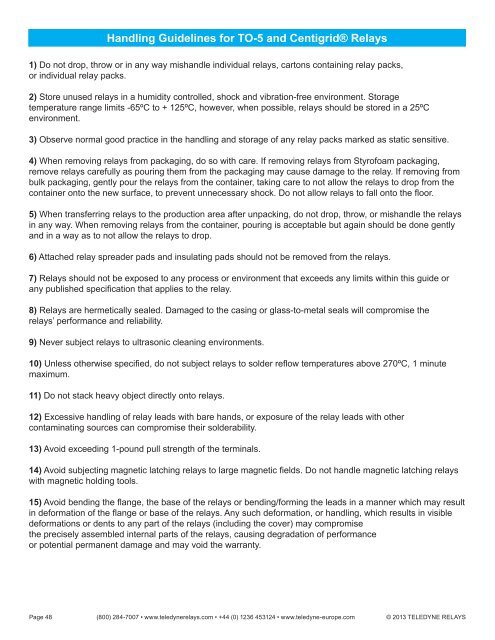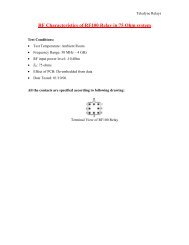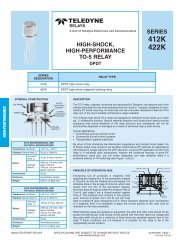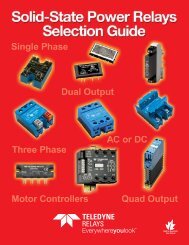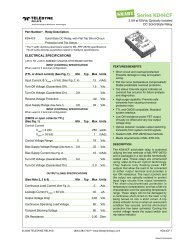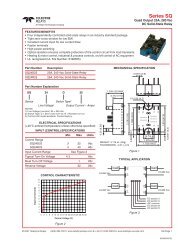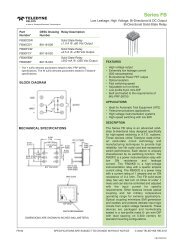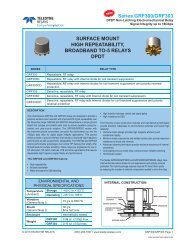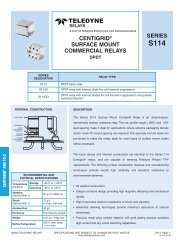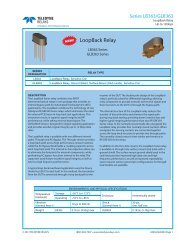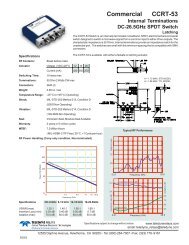2013 EMR Selection Guide.indd - Teledyne Relays
2013 EMR Selection Guide.indd - Teledyne Relays
2013 EMR Selection Guide.indd - Teledyne Relays
Create successful ePaper yourself
Turn your PDF publications into a flip-book with our unique Google optimized e-Paper software.
Handling <strong>Guide</strong>lines for TO-5 and Centigrid® <strong>Relays</strong><br />
1) Do not drop, throw or in any way mishandle individual relays, cartons containing relay packs,<br />
or individual relay packs.<br />
2) Store unused relays in a humidity controlled, shock and vibration-free environment. Storage<br />
temperature range limits -65ºC to + 125ºC, however, when possible, relays should be stored in a 25ºC<br />
environment.<br />
3) Observe normal good practice in the handling and storage of any relay packs marked as static sensitive.<br />
4) When removing relays from packaging, do so with care. If removing relays from Styrofoam packaging,<br />
remove relays carefully as pouring them from the packaging may cause damage to the relay. If removing from<br />
bulk packaging, gently pour the relays from the container, taking care to not allow the relays to drop from the<br />
container onto the new surface, to prevent unnecessary shock. Do not allow relays to fall onto the fl oor.<br />
5) When transferring relays to the production area after unpacking, do not drop, throw, or mishandle the relays<br />
in any way. When removing relays from the container, pouring is acceptable but again should be done gently<br />
and in a way as to not allow the relays to drop.<br />
6) Attached relay spreader pads and insulating pads should not be removed from the relays.<br />
7) <strong>Relays</strong> should not be exposed to any process or environment that exceeds any limits within this guide or<br />
any published specifi cation that applies to the relay.<br />
8) <strong>Relays</strong> are hermetically sealed. Damaged to the casing or glass-to-metal seals will compromise the<br />
relays’ performance and reliability.<br />
9) Never subject relays to ultrasonic cleaning environments.<br />
10) Unless otherwise specifi ed, do not subject relays to solder refl ow temperatures above 270ºC, 1 minute<br />
maximum.<br />
11) Do not stack heavy object directly onto relays.<br />
12) Excessive handling of relay leads with bare hands, or exposure of the relay leads with other<br />
contaminating sources can compromise their solderability.<br />
13) Avoid exceeding 1-pound pull strength of the terminals.<br />
14) Avoid subjecting magnetic latching relays to large magnetic fi elds. Do not handle magnetic latching relays<br />
with magnetic holding tools.<br />
15) Avoid bending the fl ange, the base of the relays or bending/forming the leads in a manner which may result<br />
in deformation of the fl ange or base of the relays. Any such deformation, or handling, which results in visible<br />
deformations or dents to any part of the relays (including the cover) may compromise<br />
the precisely assembled internal parts of the relays, causing degradation of performance<br />
or potential permanent damage and may void the warranty.<br />
Page 48 (800) 284-7007 • www.teledynerelays.com • +44 (0) 1236 453124 • www.teledyne-europe.com © <strong>2013</strong> TELEDYNE RELAYS


